Online Security for a Remote Landscape

Because we don’t know how long the pandemic will last, it would be a mistake to think of having employees working from home as a momentary stopgap measure. As long as the quarantine is in place and staff members are widely dispersed, our mission is to keep our companies as productive and safe as possible.
Key steps include:
- Careful construction of a pandemic-oriented Business Continuity Plan
- Close examination of every area and process of our companies, in search of effective workarounds
- Alteration of established procedures
- Reduction or elimination of some functions
- Realignment of duties
- Revised training methods
- New ways of holding meetings
- Documentation of new processes and procedures
- Modification of communications at all levels
Cyberthreats on the rise
The growth of remote workforces has weakened many organizations’ normal protections, resulting in a new generation of malware and cyberthreats. New varieties of fraudulent clickbait appear in the form of fictitious cures and bogus pandemic services, along with the usual scams.
Home workplace defenses
- Whenever possible, remote workers should take home the devices they use in their offices. These machines are already set up with requisite functions, from firewalls to corporate policy features to malware defenses.
- If people must use their own equipment, these personal devices should be equipped with the same types of protection utilized in the office.
- Strong and up-to-date firewalls are a must.
- No home PC should go into service without solid antivirus resistance.
- Employees working with their own PCs should make certain that their network connections are secure.
- A VPN adds an extra layer of safety by protecting passwords and other individual information.
- All updates and patches should be installed to ensure that home PCs can deliver optimum performance.
- Employees should be kept aware of the latest cyberthreats.
- Because cybercriminals are now working overtime, workers should be especially vigilant regarding iffy links and unrecognized emails.
- Personal details should never be shared.
- Remote employees should keep an eye on network traffic and be wary of presences that appear suspicious. A widely dispersed workforce can make it easier for bad actors to invade networks.
- The safety of all endpoint devices should be verified because they are among the most inviting targets for cyberattacks. These include computers, smartphones, tablets, USB drives, and any other hardware attached to the system.
- All data must be frequently backed up and safely stored, and bolstered with strong disaster recovery capabilities. This is especially important in remote environments where interruptions, spilled beverages, rambunctious kids, and equipment failures can cause damaging data losses.
- Security-assured solutions should be used when sharing files. Negligent file-sharing can be as damaging as outright file theft.
- Through backup is needed for rolling back to previous versions or times.
- When video cameras are not in use, they should be blacked out to prevent hackers from spying.
- Employees must be sure that no one else uses computers that have been pressed into service. Games, private emails, remote schoolwork, and other online content can pose severe dangers.
This is a lot to take in, and conducting business when your workforce works remotely is a tremendous undertaking. But you need not face the task alone. RenovoData can provide solutions that assure your remote users of solid defenses against disaster as well as effective recovery when problems do occur. To learn more about powerful protection against threats posed by the effects of COVID-19, call us at 1.877. 834.3684 or email us at info@renovodata.com.